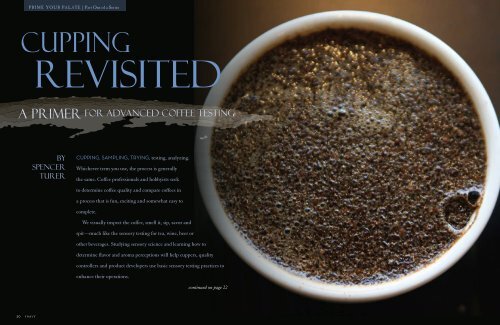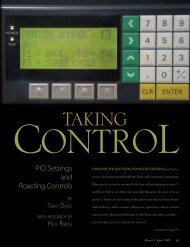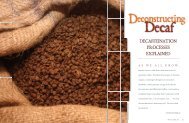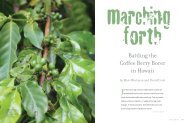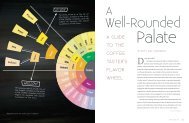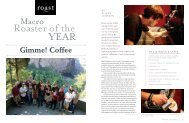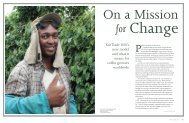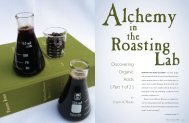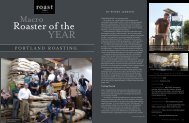Cupping revisited - Roast Magazine
Cupping revisited - Roast Magazine
Cupping revisited - Roast Magazine
You also want an ePaper? Increase the reach of your titles
YUMPU automatically turns print PDFs into web optimized ePapers that Google loves.
Prime your Palate | Part One of a Series<br />
cupping<br />
<strong>revisited</strong><br />
A PRIMER FOR ADVANCED COFFEE TESTING<br />
by<br />
Spencer<br />
Turer<br />
CUPPING, SAMPLING, TRYING, testing, analyzing.<br />
Whichever term you use, the process is generally<br />
the same. Coffee professionals and hobbyists seek<br />
to determine coffee quality and compare coffees in<br />
a process that is fun, exciting and somewhat easy to<br />
complete.<br />
We visually inspect the coffee, smell it, sip, savor and<br />
spit—much like the sensory testing for tea, wine, beer or<br />
other beverages. Studying sensory science and learning how to<br />
determine flavor and aroma perceptions will help cuppers, quality<br />
controllers and product developers use basic sensory testing practices to<br />
enhance their operations.<br />
continued on page 22<br />
20 roast<br />
March | April 2010 21
<strong>Cupping</strong> <strong>revisited</strong>: A Primer for Advanced Coffee Testing (continued)<br />
The Science of <strong>Cupping</strong><br />
<strong>Cupping</strong> is the purest way to evaluate coffee’s basic<br />
attributes—fragrance, aroma, sweetness, acidity, body,<br />
aftertaste, uniformity and cleanliness—and to experience<br />
and appreciate the individuality of each coffee. The coffee<br />
is unadulterated and unfiltered to ease the identification of<br />
defects. Before making a purchasing decision, cupping is<br />
the best way to assess quality and determine each coffee’s<br />
distinctive flavor and aroma profile. It can also be used as<br />
the first test for product development and quality control.<br />
During the past generation, the coffee industry<br />
has grown considerably as hundreds of new roasters<br />
and roaster/retailers have opened for business. This is<br />
certainly an exciting time to be working in coffee, yet<br />
these new business owners, managers and employees<br />
are not always given the opportunity and time-honored<br />
tradition of learning coffee sensory testing in a controlled<br />
manner. Much of the time, the priority when operating a<br />
coffee business—while directed by quality—is efficiency,<br />
profitability and customer satisfaction, with sensory science<br />
and testing being an afterthought. However, we as an<br />
industry have a history of apprenticeship and learning from<br />
those more senior and experienced.<br />
Cupper training at the side of our mentors and<br />
teachers is an efficient way to learn coffee evaluation<br />
and has served our industry well for decades.<br />
Recently, the coffee industry has embraced formal<br />
training for cupping and grading via coffee schools<br />
and trade conferences. Even so, learning by doing<br />
(or on-the-job training)—where cuppers design<br />
and judge their own training expertise—is often<br />
the norm. This individual process does not take<br />
advantage of calibrations with other cuppers and may<br />
produce unsatisfactory results.<br />
With any training program, students must<br />
practice daily the ritual of evaluating flavor and<br />
aroma and comparing coffee quality if they choose<br />
to keep their sensory abilities as keen as possible.<br />
Cupper trainings tend to focus on identifying flavor<br />
and aroma attributes rather than studying the<br />
scientific principles of sensory testing. However,<br />
cuppers must also determine the best way to reach<br />
their desired conclusion about each coffee. Deciding<br />
which coffee test to use is essential. Testers must also<br />
keep strict control over the testing and data collection<br />
processes to ensure the most accurate results.<br />
Cuppers who learn about the various types of sensory<br />
continued on page 24<br />
22 roast March | April 2010 23
<strong>Cupping</strong> <strong>revisited</strong>: A Primer for Advanced Coffee Testing (continued)<br />
testing will work more efficiently and<br />
make faster, more accurate decisions about<br />
quality and purchasing.<br />
Embracing the principles of the<br />
scientific method will help cuppers work<br />
more efficiently and effectively. The<br />
scientific method is a process used when<br />
conducting experiments. Food scientists,<br />
chemists, biologists and other professionals<br />
use this systematic approach to investigate,<br />
test and collect data.<br />
Think of each cupping as a miniexperiment.<br />
Only through the collection<br />
of data can a final decision be made on<br />
coffee quality—whether for commercial<br />
interests, product development or quality<br />
control.<br />
Individual<br />
Perspective<br />
Is your coffee cup half full or half empty?<br />
An optimistic or pessimistic personality<br />
will be the first guide, or stumbling<br />
block, to sensory testing. When you<br />
approach a new coffee, are you silently<br />
thinking, “Give me a reason to reject<br />
this coffee”? Having high standards is<br />
wonderful, and an important part of<br />
specialty coffee, but having the mindset<br />
to seek reasons for rejection is biased. On<br />
the other hand, do you think to yourself,<br />
“Give me a reason to accept this coffee”?<br />
This perspective is just as biased, as it<br />
will cloud your judgment for sensory<br />
testing.<br />
When testing for quality, cuppers<br />
should be neutral in their opinions,<br />
striving to remove any personal bias,<br />
historical issues or prejudicial opinions<br />
for an origin, shipper, importer, region<br />
or varietal. Approach each coffee with<br />
an open mind, let the coffee test be true,<br />
and judge each coffee fairly, allowing the<br />
actual flavors and aroma to guide the<br />
evaluation.<br />
Components of<br />
a Good Test<br />
Many pitfalls can affect the outcome of<br />
a test. Cuppers need to understand all<br />
of the variable elements and control for<br />
them to ensure that the data collected<br />
is not compromised or inaccurate.<br />
Variable elements include anything<br />
that may change during a test, such as<br />
water temperature, coffee dose, fineness<br />
of coffee grind, coffee profile roast, air<br />
temperature of the testing room and<br />
lighting intensity. Once these elements<br />
are managed to be exactly the same for<br />
each test, they are no longer variable<br />
factors but controlled items.<br />
Trying to judge flavor, aroma, quality<br />
and character to make a purchasing<br />
decision or quality approval from<br />
memory may be challenging, even<br />
for the most skilled cuppers. Cuppers<br />
should compare the unknown coffee to<br />
a known sample (or a standard quality<br />
sample) to test for quality. Testers<br />
should aim to use a fresh sample or<br />
recent arrival of the known/standard<br />
sample so that age and green staling<br />
are not factors in determining character<br />
differences.<br />
Cuppers should evaluate their<br />
coffee independently of other testers<br />
in the room and follow good cupping<br />
etiquette by minimizing discussion and<br />
any other distractions. They should also<br />
avoid over-analyzing a coffee sample by<br />
placing more cups than normal on the<br />
table, cupping the table an extra time<br />
“just to be sure” or asking additional<br />
cuppers to join the test. When coffee<br />
testers increase the number of cups<br />
sampled or the number of times each<br />
sample is tasted, the resulting data may<br />
change. This increases the likelihood<br />
of finding a reason to upgrade to an<br />
approval or downgrade to a rejection.<br />
How to Create<br />
an Experiment<br />
Determine the question<br />
Specifically, what are you hoping<br />
to learn? Are you testing coffees<br />
for purchase approval? Judging<br />
the acceptability of a new blend?<br />
Evaluating production samples for<br />
quality control, or testing the operation<br />
of new equipment on your coffee<br />
products? Completing descriptive<br />
analysis for retail marketing? Each<br />
question will require a unique testing<br />
protocol and process.<br />
Design the test<br />
Once you settle on your question, you<br />
can determine the best test to reach<br />
your conclusion. Will you be testing<br />
one coffee, two coffees, comparing two<br />
or more coffees, evaluating component<br />
percentages for a blend, or evaluating<br />
brew strength options? For each<br />
question, there may be a different<br />
test that is best suited to collecting the<br />
right data (see page 30 for more on<br />
this). Before testing begins, you must<br />
determine the standard for acceptance.<br />
If you will be using the Specialty<br />
Coffee Association of America (SCAA)<br />
cupping quality scale, what is the score<br />
necessary for an approval? When using<br />
other testing methods or scales, the<br />
criteria for success and failure must be<br />
predetermined before you begin cupping.<br />
Next, determine who will complete<br />
the testing: a coffee expert, trained panel<br />
or consumer panel. For small to medium<br />
coffee operations, one cupper (“the expert”)<br />
may make the decisions. In many coffee<br />
companies, a group or team of cuppers<br />
(“trained panel”) might make purchasing<br />
continued on page 26<br />
24 roast March | April 2010 25
<strong>Cupping</strong> Revisited (continued)<br />
decisions, and a separate group of coffee enthusiasts may<br />
be asked to emulate the consumer experience for product<br />
development tests. Consumer marketing groups may be<br />
enlisted to perform actual consumer testing.<br />
Conduct the test / Collect the data<br />
Coffee sensory testing should use quantitative analysis for<br />
data collection, which means using measurable scales for<br />
the amount of perceived character, as opposed to qualitative<br />
analysis where subjective judgment is recorded.<br />
To collect measurable data, use a cupping score chart<br />
or custom-created chart to indicate the perceived tastes and<br />
character intensity of each sample. For example, a scale of<br />
1 (no character) to 10 (intense character) is often used for<br />
sensory analysis. Qualitative analysis—using one’s judgment<br />
or opinion to describe the coffee—is best used for descriptive<br />
analysis and not for purchasing or quality questions.<br />
Care must be taken when preparing coffees for sensory<br />
testing. The goal is to manage for all of the variables so that<br />
the only aspect actually tested is the quality or character<br />
and the intensity of the quality and character. Examples of<br />
variables to manage and control for include water temperature<br />
and quality; cup shape, size and composition; and waiting<br />
time before testing. For green coffee testing, a representative<br />
sample of a lot (full container) is required to be drawn from<br />
at least 10 percent of the bag count from several different<br />
locations to prevent testing of just one “pocket” of coffee.<br />
Green samples must be mixed to be sure that all beans,<br />
including defects, are randomly located within the sample<br />
before testing.<br />
Keeping a consistent roast level for all samples is critical.<br />
Small changes in the roast profile will impact a coffee’s flavor<br />
development, acidity, body and sweetness. Any differences<br />
in roast profile may cause unfounded bias for or against<br />
particular samples that bear no reflection upon the inherent<br />
quality of the cup and thus change the test results and<br />
conclusions. The date and time of roasting should also be the<br />
same for all coffees so that roasted staling is not a variable in<br />
the test.<br />
The SCAA cupping protocols recommend using a light<br />
roast (58–63 Agtron) to provide the best opportunity to<br />
identify defects. Many roasters use a production roast level for<br />
their cuppings to allow the coffee to demonstrate its character<br />
from the consumer perspective.<br />
Cuppers should begin by documenting all measurable<br />
variables—the external factors and unforeseen issues that<br />
may influence the outcome of the test. When repeating tests<br />
over time, it will become obvious which variables need to<br />
be measured and which factors will not affect the outcome.<br />
Noting all measurable variables may be difficult when<br />
conducting informal testing, such as developing drinks at the<br />
barista bar or testing brewing processes. Nonetheless, cuppers<br />
must understand the details of the test to replicate it for<br />
further evaluation.<br />
Consumer-brewing processes—drip, French press, extract<br />
or Clover—also provide valuable tools when testing for<br />
A simple cupping form, available for free download at<br />
www.roastmagazine.com/cuppingform<br />
consumer acceptability. Brewing tests should follow a similar scientific<br />
method, with consideration for how the consumer would individually<br />
brew and serve the coffee, or how the retailer would prepare the<br />
beverage for sale. Testing the coffees black and also garnished with<br />
sweeteners and dairy will help provide the full range of data needed to<br />
make consumer-oriented conclusions.<br />
Using non-professional tasters in consumer tests may generate<br />
higher-value data. Regular consumers and frequent coffeehouse guests<br />
would be the best testers; non-coffee drinkers or those unfamiliar<br />
with the products may skew the results too far positive or negative.<br />
Even those who drink coffee regularly may have unforeseen biases or<br />
misunderstandings about quality. These factors should be taken into<br />
account when using these testers, as the results may be valid only for<br />
purchase preference, purchase intent or post-purchase satisfaction,<br />
without resulting in usable data for actual coffee quality.<br />
Analyze the data and make your conclusion<br />
When all aspects of the testing are complete, with confidence that all<br />
variables were managed and controlled for, the data can be reviewed<br />
against the predetermined success criteria to reach an ultimate<br />
conclusion. Let the coffee and the data—not personal opinion—<br />
determine the conclusion.<br />
continued on page 28<br />
26 roast March | April 2010 27
<strong>Cupping</strong> <strong>revisited</strong>: A Primer for Advanced Coffee Testing (continued)<br />
Test the results<br />
In an often-overlooked last step, cuppers who repeat a test<br />
should compare the data collected and the conclusion to prior<br />
tests. Are they the same? If so, this verification process allows<br />
the cupper to be confident that the correct conclusion was<br />
reached.<br />
If there is any inconsistency in the data or conclusion,<br />
one of the following problems may be to blame: 1) serious<br />
issues with the testing method, 2) calibration/consistency<br />
issues among the cuppers, 3) improper data analysis, 4)<br />
inconsistencies in the item being tested, or 5) the inability to<br />
confirm the conclusions.<br />
When repeating tests, the order of the items being tested<br />
may be changed, reversed or randomized to ensure that<br />
results are true, accurate and independent of the testing order.<br />
It may be necessary to repeat tests, especially when using the<br />
consumer perspective, at various times throughout the day:<br />
mid-morning when taste buds are most sensitive, after lunch<br />
to replicate interference with other flavor and aroma factors,<br />
or late afternoon when fatigue sets in. Sensory perception<br />
testing is complicated, and human fallibility should be<br />
considered, especially when a single tester is used. Cuppers<br />
should take into account emotional factors that may influence<br />
their judgment or distractions that may inhibit concentration.<br />
Again, a second testing may be necessary to verify the results and<br />
conclusions.<br />
When conducting a series of sensory tests, the first item tested<br />
in a series sets the standard and may receive a higher rating simply<br />
because it is tested first. To protect against this, set a calibration<br />
sample to cup first before collecting any data, or repeat the first<br />
sample within the series to determine if the score is the same at<br />
both positions.<br />
Conducting proper tests will not only help build confidence<br />
and expertise, but it will also help cuppers answer supplier and<br />
customer questions about quality evaluations. Testing will help<br />
to reject the coffee that should be rejected and to approve the<br />
coffee that should be approved, based on unbiased and scientific<br />
data collection. The opposite—approving a coffee that should<br />
be rejected because of a bad test or poor testing process—could<br />
be devastating to your business financially and your reputation<br />
among your suppliers and customers. Approving a bad coffee may<br />
set a precedent for quality that you are not proud of. This, in turn,<br />
affects the quality of future deliveries from suppliers because of<br />
inconsistent quality communications, or it may cause you to lose a<br />
customer based on what you thought was great coffee but, because<br />
of a bad test, is actually inferior. Who wants to reject great coffee<br />
and allow it to be sold to a competitor because of a bad test that<br />
yielded the wrong result?<br />
Rejecting a coffee that should be accepted could also be<br />
financially devastating for a producer, particularly in relationship/<br />
direct trade purchases, since premiums may be lost or the<br />
coffee could ultimately go unsold. It is the duty of the tester to<br />
understand the importance of the test and its implications for<br />
the stakeholders of the coffee, and to remain true, unbiased and<br />
professional in all aspects of the evaluations.<br />
Those new to the scientific testing method may find the<br />
process very detailed and cumbersome, but, with practice, these<br />
concepts will become as familiar to you as any other process in the<br />
roastery. Understanding the basics of sensory testing and choosing<br />
to apply these principles to cupping will advance the caliber and<br />
credibility of your quality testing. After all, specialty coffee is a<br />
matter of choice, not a beverage of chance.<br />
SPENCER TURER pulled his first shot of espresso in 1991 and first<br />
roasted coffee in 1995. He is a graduate of Johnson & Wales University<br />
with degrees in culinary arts and food service management and is a<br />
specialty coffee professional with Mitsui Foods in New Jersey.<br />
choose your test: the basics<br />
of testing and testing types page 30<br />
28 roast March | April 2010 29
<strong>Cupping</strong> <strong>revisited</strong>: A Primer for Advanced Coffee Testing (continued)<br />
CHOOSE YOUR TEST<br />
the basics of testing<br />
Monadic<br />
When one product is tested by itself without<br />
a comparison. For example, try this coffee<br />
and provide your cup results. A cupping table<br />
set with one flight each from different origins,<br />
without comparison to a standard or baseline,<br />
provides a series of monadic tests.<br />
Comparison<br />
Tests two or more coffees—an unknown coffee against a known—to compare the<br />
cup character. Product development departments often use this type of testing<br />
when considering blend variations for product rationalization or new product<br />
development. Comparison will allow several different coffees to be tested next<br />
to each other. This type of test can be completed through cupping or with<br />
brewed coffee, either as an objective test by professional tasters or a subjective<br />
test by consumers.<br />
types of product testing<br />
Preference<br />
Primarily used as a consumer test. With all<br />
aspects of the test controlled, the questions<br />
are: Which coffee do you like better, and why?<br />
Preference testing is purely subjective and based<br />
on opinion. It can be used to test brew strength,<br />
hold times, blend development or roast levels.<br />
Paired Comparison<br />
Used to compare two coffee samples side by<br />
side with a specific question asked. For example,<br />
which sample has higher acidity? This test<br />
forces the taster to make a firm decision. Paired<br />
comparison tests are fast and easy to conduct,<br />
but the success or failure criteria must be<br />
determined before the test begins. For instance:<br />
How may cuppers need to score the same for the<br />
results to be conclusive, and how many times can<br />
those cuppers reach the same results each time?<br />
Threshold<br />
Determines the level that one can perceive<br />
a change or detect that a flavor or aroma is<br />
present. More detailed threshold tests assess the<br />
expert tester’s ability to recognize or identify the<br />
change. The SCAA Sensory Skills Test uses this<br />
method. When seeking to change a coffee blend,<br />
a roaster will use a threshold test to compare two<br />
samples and identify at what level a variation in<br />
the blend can be detected.<br />
Sorting<br />
After the threshold test is complete and the<br />
cupper is able to identify variations in the coffee<br />
characters (acidity, sweetness, body), the sorting<br />
test allows cuppers to rank the intensity of each<br />
character (strong, medium, weak). In advanced<br />
sorting, cuppers must identify at least two<br />
different characters within each cup and rank<br />
them individually on the intensity scale. Again,<br />
this is part of the SCAA Sensory Skills Test.<br />
Triangle<br />
A powerful test when determining if two items<br />
are virtually the same or different in character,<br />
flavor and aroma. Triangle tests are a series of<br />
duplications to ensure that the cupper is not<br />
guessing and can replicate the results in various<br />
orders. This gives true confidence in the data<br />
collection and conclusion. The three samples<br />
provided to the cupper are randomized to test the<br />
confidence of the scores and remove the cupper’s<br />
opportunity to guess correctly.<br />
To explain, Sample A and Sample B are<br />
being compared. Sample A must be placed in all<br />
three positions to test the cupper’s real ability to<br />
determine a difference; the same format will be<br />
used to test Sample B in each position.<br />
AAB BBA<br />
ABA BAB<br />
BAA ABB<br />
AAA BBB<br />
When most or all of the cuppers score these<br />
samples correctly, there is confidence that the<br />
samples are identified as different. When most of<br />
the cuppers score incorrectly, there is increased<br />
confidence that the variations and differences<br />
between the coffees cannot be detected.<br />
Duo-Trio<br />
Determine which of two test samples is the same<br />
as the reference sample provided. This test<br />
gives cuppers a greater opportunity for guessing<br />
correctly than the triangle tests, making it less<br />
powerful. To ensure accuracy in duo-trio tests,<br />
some tests must be designed with three identical<br />
samples and others where both samples are<br />
different from the reference sample.<br />
Changing the sample positions—and creating<br />
all the same or all different sample sets—is not<br />
intended to confuse the cuppers. On the contrary,<br />
this is designed to increase the confidence in<br />
the test results by providing the cupper the<br />
opportunity to accurately identify the differences<br />
and similarities in the coffees in a variety of ways.<br />
Descriptive Analysis<br />
A process used by sensory testers to communicate<br />
the specific flavor and aroma perceptions to a<br />
level where most individuals can detect the same<br />
perceptions. Descriptive analysis is intended to<br />
include flavor and aroma characteristics that most<br />
people can perceive; when they see the words<br />
written in a coffee description, it should make<br />
sense. For example, describing a particular coffee<br />
as exhibiting a “sweet fresh raspberry acidity with<br />
light caramel characters and a lingering chocolate<br />
aftertaste” is a descriptive analysis.<br />
This test is controlled by a group of judges<br />
who first create individual lists of descriptive<br />
words to use. Next, the judges agree on a standard<br />
vocabulary list for the test. Finally, they evaluate<br />
the coffee, working in groups to reach a consensus<br />
for the coffee’s profile. The group consensus is<br />
vital to create a descriptive analysis without using<br />
a single person’s individual opinion for the coffee’s<br />
profile.<br />
The success of a good descriptive analysis<br />
is when the consumer is able to understand the<br />
coffee character by reading the menu description<br />
and then agrees with the description after tasting<br />
the coffee. A poor product description from this<br />
analysis includes references unknown to the<br />
consumer or flavor and aroma characteristics<br />
that are not perceived by most people, cause<br />
confusion, or reduce the purchase intent of the<br />
coffee.<br />
30 roast<br />
March | April 2010 31


